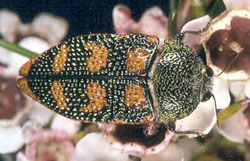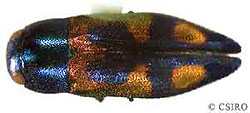|
BUPRESTIDAE: Jewel Beetles
Jewel beetles are likely one of the most easily recognisable families due to their striking colours. During the warmer months these beetles are often seen on the flowers of trees and shrubs. They are small to large beetles and range in size from 3 to 65 millimetres in length. They have an elongated body shape which tapers towards the abdomen and a short head, which fits closely into the broader thorax. They have large eyes and short antennae and can retract their legs against their body for protection. Some jewel beetles when disturbed will tuck their antennae and legs into their body and drop to the ground as a defence against predators. The elytra are tough and longitudinally grooved and usually brightly coloured, sometimes metallic. While most adults are nectar feeders (especially on Eucalyptus blossoms) or leaf feeders, the larvae are wood borers, feeding on the sapwood under the bark of native trees and shrubs. A few species are also known to be leaf miners or gall forming species. Larvae look like fleshy, white, legless grubs with strong mandibles. They pupate inside the wood of the host plant and when ready to emerge the adults bore their way to the outside. On emerging the adults feed, mate and then die in a relatively short time. The life span of jewel beetles is short and depending on the species, adult beetles may live for just one or two days up to about two weeks.
Jewel beetles
have in the past been used by native people as jewellery and ornaments
because of their bright colours. For more jewel beetle species visit the Australian Insect Common Names. |


